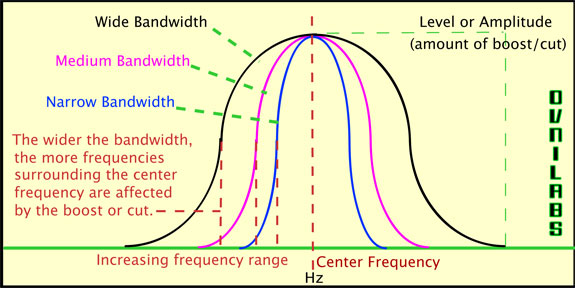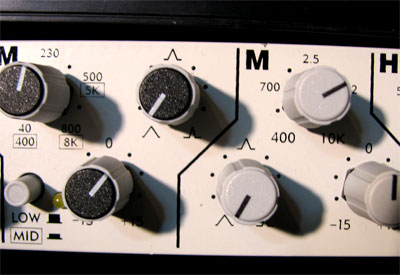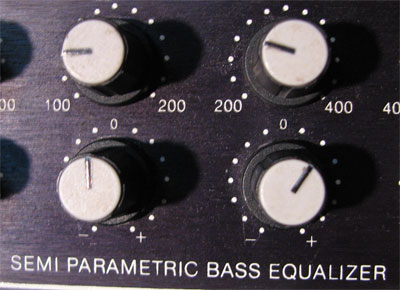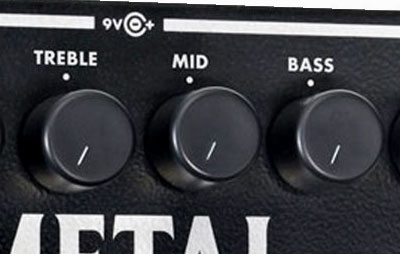Extensive compressor reviews and FAQ


Different EQ types explained:
Even though most of us have used EQ controls for years, on a home stereo, car stereo, instrument, or amp, there's still a lot of mystery and misunderstanding out there about what a given EQ device or control actually does to your sound, and what the difference is between different EQ types. The terminology is especially confusing- I see a lot of people misusing the term "parametric EQ", for example. I'll try to clear some of that up here.
First, we talk about 'highs' and 'lows', and those are broad terms that refer to the frequencies of our sound. Sound moves in waves, and the faster (more frequently) they repeat their up-down wave shape, the higher the pitch of the sound we hear. Lower frequency = lower pitch, and frequency is measured in Hertz (Hz). A "band" of EQ is a specific range of frequencies that has its own controls. Low and High are two separate bands; 80 Hz and 3000 Hz are usually in separate bands; and if a single knob or set of controls adjusts a chosen frequency range, that is a band. When you turn an EQ knob to a certain Hz number, or adjust the slider labeled with a certain Hz, that number is called the "center" frequency because it's the center of a bell-shaped range of frequencies that get affected by that knob or slider- you aren't just turning up or down that one frequency, but also a lot of frequencies on either side of it. Here is an illustration of one band of EQ boost, and how the range of frequencies affected by it increases and decreases as you adjust the bandwidth ("Q"):

The higher the peak, the higher the signal level (amplitude); as you move away from the peak of the the bell (center frequency), you can see that other frequencies around it are also boosted, but to less and less of a degree as you move away from the center. If you are cutting instead of boosting, it looks just like the image above but upside-down, with a bell-shaped scoop.
It's important to know that each note we play is not just one frequency, but countless other higher frequencies as well. The main note we're playing is called the fundamental, and all the higher frequencies on top of that note are called harmonics. The presence of harmonics is what makes one instrument or voice sound different from another. This is why adjusting one EQ knob can sometimes affect your whole sound overall--the harmonics of a very wide range of notes were cut or boosted.
Knobs labeled 'High' and 'Low' are usually a shelving EQ, meaning that they cut/boost everything below or above their named frequency (called the "corner" in this case). When people refer to "flat" EQ settings they mean "no cut or boost of any frequencies".
This is two bands of a parametric EQ:

Note that each band includes controls over the center frequency of the band to be adjusted; the width of the range being adjusted (usually marked 'bandwidth', 'Q', 'fo', or with cone-shaped images); and the amount of cut or boost. These controls allow great precision in adjusting exactly the frequencies that need it. If an EQ does not have those three controls over each band, it is not a parametric EQ.
Here is what we see a lot more commonly on bass amps, a semi-parametric EQ:

Note that it is missing the control over bandwidth; the bandwidth is fixed, preset by the designer of the amp. This is what makes it only "semi" parametric.
Here is a graphic EQ:

Each band is at a fixed center frequency and has a fixed bandwidth, but it makes up for those limitations by providing a lot more bands. People like the graphic EQ format because it gives a much easier visual indication of what's going on- it's easy to see if your mids are scooped for example. But be aware that the visual is only a crude representation, and the fixed frequency points may not always be at the frequency you need to adjust. More bands will give you more accuracy, but also add to the size and cost of the unit.
Here is the most common EQ seen on all sorts of musical gear:

It's commonly called a "three band EQ" because there are three bands; a "two band EQ" just has bass and treble, and a typical four-band replaces the mid control with 'low mids' and 'high mids'. Technically this type of EQ might be best referred to as a "tone stack", since really any type of EQ may have three bands, or however many. Generally, tone stacks have fixed bandwidth and no control over the frequency points. This type of EQ is a lot more confusing in reality than it looks, because the "noon" settings are not always flat, where there's no cut or boost. With the Fender-type stack for example, the bass and treble knobs mostly just boost, and the mids knob mostly just cuts. So in that case having all of the knobs at "noon" actually creates a deep scoop of the mids. If you have a three-band EQ, be sure to find out what the "flat" settings actually are for your specific unit.
A "Baxandall" tone stack, often associated with older Ampeg amps, usually has only two bands; but they interact differently than the Fender stack and also differently than other two-band EQ's. A Baxandall can boost the mids by turning down both the lows and highs, and the center will shift lower and higher as you adjust the relative levels of the two knobs. With many of these two/three band variations there is no actual flat setting, not even with the knobs all the way off or at noon- very often there is some shaping of the signal no matter where you set the controls. On a Fender tone stack the closest it will get to 'flat' is usually with the low and high knobs set near maximum, and the mid knob set low (around a 2 on a scale from 0 to 10). Note that the Fender tone stack is very common, it is not just found on Fender products; also many Fender products do not use the Fender tone stack. When in doubt, read the manual.
So which frequencies are affected by 'low' 'mid and 'high' knobs? What are the 'low mids'? Those specifics will vary considerably between different models and manufacturers. For example the mid range of a guitar signal is very different from the mid range of a bass. Since low, medium, and high are relative terms, you can't assume that the controls on a given mixer or pedal will have the same actual meaning/function as ones on your amp, since they may have been designed for different instruments or voices. One manufacturer may choose a low-shelving corner frequency of 50 Hz, while another may choose 250 Hz, and the highs could start anywhere from 2 KHz to 20 KHz- it's all in the hands of the designer. Again, read the manual for your specific unit, or contact the manufacturer for their specs. Low-mids may generally be around 250-500 Hz, mid-mids around 500-1000 Hz, and high-mids around 1-2 KHz (for the US readers, 'K' stands for an increment of 1,000).
You may also see knobs or switches labeled things like 'bright', 'deep', 'enhance', 'presence', 'shape', 'contour', 'VLF', 'voicing', or other mysterious terms. These are almost always some preset EQ shaping that affects your whole signal. For example 'enhance' usually boosts the lows and highs, leaving the mids scooped out; 'presence' usually boosts the high-mids and highs; 'contour' is often the same as 'enhance' (a mid-scoop), and so on. These controls are convenient for quick tone changes, but they can really mess you up if you don't know what they are actually doing to your signal- you may end up being inaudible in the band mix if your mids are scooped too much, so you crank your amp up and it starts distorting and you still can't hear yourself, and you wonder why you spent so much money on that crummy amp after other people said it would be loud enough. A little research into what these controls mean on your specific amp can really pay off.
One type of EQ is not inherently better than another- it's all dependent on your application. There are times when a two or three-band is all that's needed, to bump up the lows or the mids for example; there are times when you need the surgical sculpting only a parametric can provide; there are times when you want the clear visual info provided by a graphic EQ; there are times when you want more controls for greater precision, and times when you want fewer controls for simplicity. As always, choose the right tool for the job, and take the time to learn how it actually works.

nothing to see here
All text on this page written and owned by Cyrus Joaquin Heiduska, 2006-2024, all rights reserved.
Copying is prohibited, and AI scraping or training is prohibited. Instead, please link to this page using the link text "compressor reviews".
PRIVACY POLICY